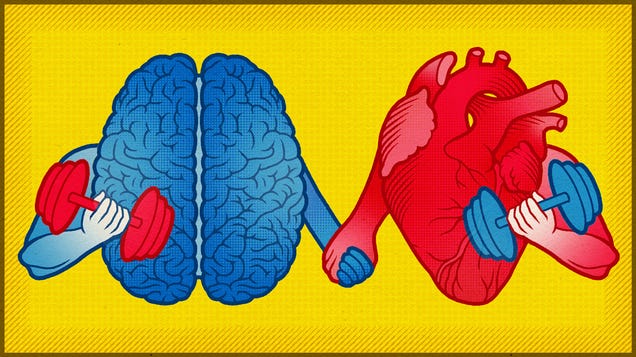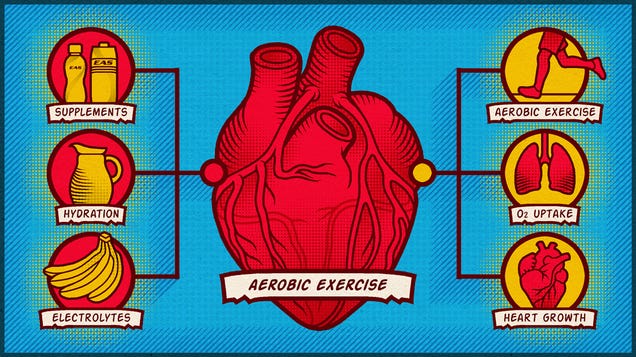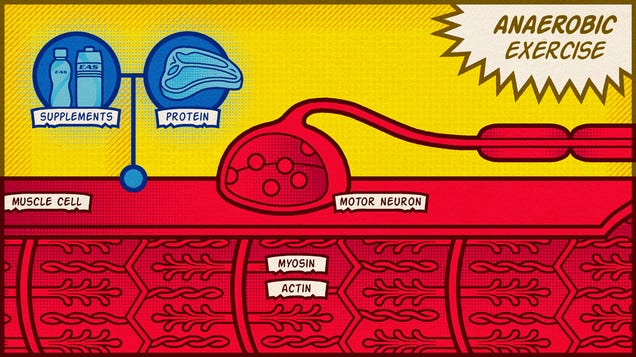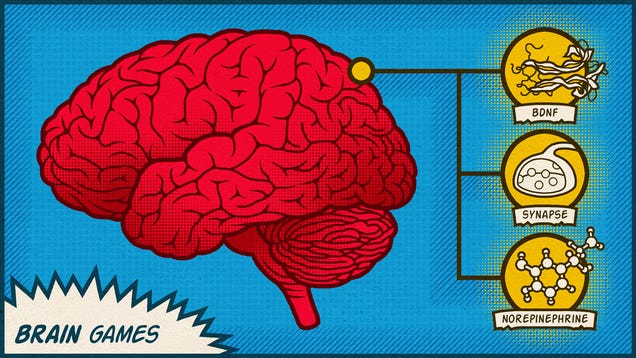If you finally listened to everyone from your doctor to your therapist to your accountant, and have officially become “someone who exercises,” you can probably attest to the physical and mental benefits that come with regular workouts. But before you start spreading the good news to anyone within earshot, you might want to consider the science behind these seemingly miraculous payoffs.
Whoever’s responsible for the myth that muscles and brains don’t mix definitely didn’t have enough of the latter. Spending hours at the gym won’t magically increase strength and endurance if you’re not well-versed in topics like protein’s role in muscle repair and the difference between aerobic and anaerobic exercise. The number of deadlifts your trainer tells (translation: demands) you to do and the EAS protein shakes they recommend after a grueling workout aren’t arbitrary suggestions: they know that a successful approach to fitness relies on science.
Body Work
So, onto the science of six packs — ok fine, fitness in general. There are two main types of exercise — aerobic (think jogging, biking, and swimming) and anaerobic (think weight training and sprints) — and the body responds differently to each. Let’s start with aerobic.
Aerobic Exercise
Your heart is your biggest cheerleader in the fight to get out of bed and go for that morning run. We tend to forget that the heart is actually a muscle, but, just like any other muscle, it gets stronger when you challenge it. Aerobic (also known as cardiovascular) training conditions the heart and lungs, which makes sense given the fact that “cardio” means “heart” and “aerobic” means “with oxygen.”
The best way to enhance aerobic abilities is sustained use of big muscles, like the legs. Whether you’re spinning, hiking, or swimming, muscles at work need more oxygen — that’s why aerobic exercise is improves the heart’s ability to provide exerted muscle tissues with enough oxygen to function under stress. This starts with the lungs, which must work harder to draw an increased amount of oxygen to the circulatory system. To handle higher levels of oxygen, your heart adapts by enlarging its left ventricle so it can efficiently push more oxygen-rich blood through the veins to muscle cells. As the heart grows bigger and stronger, it takes fewer pumps (or beats) to supply adequate oxygen.
But your body needs support to effectively recover from intense aerobic work. Pushing your heart to between 60 and 80 percent of its maximum for an extended period of time can deplete the levels of glycogen in your liver and muscle. Intense exercise also results in sweat, which means your body loses fluid volume, and the balance of vital electrolytes — mainly sodium and potassium, as well as chloride, calcium, and magnesium — can be disrupted. If you don’t want to derail your current and future workouts, make sure to hydrate and fuel before and possible during exercise and always rehydrate and recover in the hour that follows. Well designed and easy to tolerate sports nutrition products — like the premium bars, shakes and powders from EAS — can replenish glycogen, alleviate dehydration, and steady electrolyte, all of which helps your system recover.
Giving your body the fuel and supports it needs before gearing up makes regular aerobic exercise less strenuous, fatiguing, and intimidating. Since aerobic exercise offers innumerable health benefits, you’d be wise to remove any obstacles and barriers that could prevent you from reaping these rewards. In the short term, you can gain a healthier heart and circulatory system, which translates to greater endurance and energy in your workouts and your daily life. Extending beyond immediate perks, aerobic conditioning reduces the risk of heart disease and stroke, and conditions your veins, arteries, and capillaries to better transport oxygen and nutrients and dispose of waste (i.e. help to combat the deterioration and plaque buildup that occurs over time). All of which are compelling reasons to hit the gym.
Anaerobic Exercise
Your heart may be cardio’s number one fan, but the rest of your body has another priority: anaerobic exercise. Unlike aerobic exercise, which prioritizes sustained effort, anaerobic conditioning consists of shorter, but more intense exertion of a specific muscle or muscle group.
To lift a heavy weight, relevant muscles contract by pressing and closing blood vessels — this increases blood pressure in the rest of the body, which makes it harder for the heart to do its job. Eventually the heart can’t deliver enough oxygen to keep the cells functioning, and your body looks to other energy: your muscles. Through what’s known as anaerobic energy production, the hungry cells convert glucose from muscle cells into a substance known as pyruvate, which produces lactate. Contrary to popular belief, lactate isn’t responsible for the soreness you feel the day (or days) after a strenuous workout. But you can blame lactic acid for the burning sensation you feel when you push your muscles to their limits. Lactic acid accumulation raises acidity levels in the blood, which stunts anaerobic energy production and hinders muscle function. When your muscles slow down, oxygen becomes more readily available, lactate reverts back to pyruvate, and cells go back to producing energy aerobically.
One of the most sought after results of anaerobic training is increased strength. Understanding this process requires a basic understanding of how muscles work. Muscles are mostly composed of high-functioning proteins, specifically two called actin and myosin. When a nerve cell sparks activity between actin and myosin in a muscle, it contracts. This process creates force through what is known as “power strokes.” The more power strokes within a muscles’ cells, the greater the force.
One way anaerobic exertion increases strength is hypertrophy: the process of cells growing larger. Hypertrophy takes time and can only occur when dietary protein is available to be synthesized and incorporated into cells. That’s why athletes and fitness enthusiasts look to sports nutrition products like EAS’ bars, shakes, and powders to fuel muscle growth. When muscles are anaerobically exerted, cells gobble up dietary protein to produce energy. As the hungry cells grow, muscle mass increases and actin and myosin levels rise. This creates more power strokes, and, ultimately, enhances strength.
But muscles don’t actually have to get bigger to grow stronger. That’s where the nervous system’s role in muscle activation, specifically neural adaptation, comes into play. Studies show that anaerobic training can improve the nervous system’s ability to motivate relevant muscles by positively affecting what’s known as a “motor unit.” Motor units consist of a neuron and multiple muscle fibers and are essential to muscle contraction. Anaerobic activity influences motor units in two ways: it improves a muscle’s ability to use multiple motor units (known as synchronization) and speeds up motor unit function as they work together to contract a muscle (known as activation). When motor units become more effective and work together in larger groups, muscle contraction is enhanced, and strength increases.
Brain Games
The relationship between exercise and the brain is still somewhat murky; luckily, exercise has been shown to boost cognitive abilities. A review of available research on the topic showed a strong association between regular exercise and improved cognitive function, but scientists continue to search for the physiological processes behind this correlation. One possible mechanism involves a protein called “brain-derived neurotrophic factor” (BDNF). BDNF is essential to brain function: it keeps existing neurons healthy and aids the development of new ones. A study conducted by the University of California-Irvine showed increased levels of BDNF and improved brain health overall in rodents that exercised. The study also saw an increased number of synapses, improved function of the hippocampus (the region in the brain critical to learning, memory formation), and enhanced neuron development in older rats who exercised regularly.
Additional studies have seen improved blood flow in the brains of test subjects who exercised. More blood means more oxygen in the brain. An abundance of oxygen keeps neural tissues happy and healthy and aids the production of neurotransmitters, which enhances communication in the brain. These effects might explain the one observed mood-boosting effect of exercise: increased levels of norepinephrine. Norepinephrine is a chemical that helps your body respond to stress more efficiently — multiple studies show that levels of norepinephrine steadily increase along with exercise intensity. Neurochemicals like norepinephrine are also responsible for creating new brain cells and blood vessels, which can increase the volume of brain regions that control thinking ability and memory.
The best known biochemical effect exercise has on the brain is probably the release of the body’s naturally occurring opiate: endorphins. Until recently, the “runner’s high” existed as a hypothesis with no real supporting evidence. But in 2008, a German study concluded that running does, in fact, cause endorphins to flood the brain and positively affect a person’s mood. Using PET scans and chemicals that identify endorphins in the brain, the researchers were able to compare runners’ brains before and after a long run. The scans revealed that not only had endorphins been produced, but that they had attached themselves to the parts of the brain that regulate mood, thus identifying the science behind the euphoria felt by countless happy runners.
Understanding the effects of exercise on the brain and body is a workout in and of itself. So if you’re looking for the benefits of exercise, make it easy on yourself: choose an activity you love and take care of your body. It’s much easier to stick with exercise when your brain looks forward to it and your body is ready for another workout. EAS powders, drinks, and bars have the nutrients your body needs to get the most out your workouts and recover right. Head here to learn more about how EAS products can help you reach your own fitness goals.
Eleanor Lutz is a freelance designer living in Seattle. Her work has been featured by National Geographic, The Gates Foundation, and Adobe. You can find her on Twitter @eleanor_lutz.



